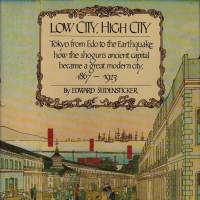Best known for his translations of "The Tale of Genji" and the fiction of Yasunari Kawabata, for which the author won a Nobel Prize, Edward G. Seidensticker was also an accomplished essayist and historian.
Low City, High City, by Edward G. Seidensticker.
KNOPF, Nonfiction.
The first of a two-volume history of Tokyo, "Low City, High City" covers the years 1867 to 1923, when Tokyo, as well as the rest of Japan, joined the modern world after centures of feudalism. Written in a style conversational but not slangy, witty but not snarky, the book is packed with colorful anecdotes and pointed observations based on Seidensticker's thorough primary-source research and long acquaintance with the city. (For decades, he alternated between residences in Tokyo and the United States, finally dying here after a fall near Shinobazu Pond in 2007.) It is not only an absorbing read from cover to cover, but can also be dipped into at any point with pleasure.
There is not much about city-hall politics, but quite a lot about changing social customs and mores. Distinguished visitors are duly noted, such as former U.S. President Ulysses S. Grant, who stopped in Tokyo in 1879 during a round-the-world tour, but what one brings away are the images, such as Grant at kabuki being greeted by geisha wearing red and white kimonos and, over their exposed shoulders, star-spangled singlets. "It made the prettiest costume imaginable," wrote a contemporary diarist. It also shows that cosplay has deep roots indeed. This sort of descriptive writing, with the telling detail that brings old Tokyo vividly to life, can be found on page after page. Bedtime reading gets no better.
Read archived reviews of Japanese classics at jtimes.jp/essential.


















With your current subscription plan you can comment on stories. However, before writing your first comment, please create a display name in the Profile section of your subscriber account page.